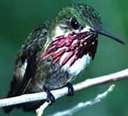 CALLIOPE
HUMMINGBIRD: (3 1/4") A summer resident
of the mountains, it's the smallest north American bird. The male's
gorget is composed of colored rays, or streaks, rather than a solid
pattern. Typical of hummingbirds, after mating , the female alone builds
the nest, incubates the eggs, and rears the young. Most adult males
depart for wintering grounds in Mexico by mid-July with females and
immature males leaving later. CALLIOPE
HUMMINGBIRD: (3 1/4") A summer resident
of the mountains, it's the smallest north American bird. The male's
gorget is composed of colored rays, or streaks, rather than a solid
pattern. Typical of hummingbirds, after mating , the female alone builds
the nest, incubates the eggs, and rears the young. Most adult males
depart for wintering grounds in Mexico by mid-July with females and
immature males leaving later. |
 Back
to Hummingbirds
Back
to Hummingbirds